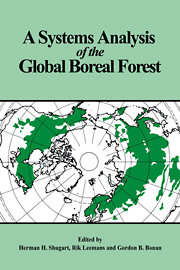Book contents
- Frontmatter
- Contents
- List of contributors
- 1 Introduction
- Part 1 Processes in boreal forests
- Part 2 Patterns in space and time in boreal forests
- Part 3 Computer models for synthesis of pattern and process in the boreal forest
- Introduction
- 12 Individual-tree-based models of forest dynamics and their application in global change research
- 13 Population-level models of forest dynamics
- 14 A spatial model of long-term forest fire dynamics and its applications to forests in western Siberia
- 15 A simulation analysis of environmental factors and ecological processes in North American boreal forests
- 16 The biological component of the simulation model for boreal forest dynamics
- 17 Role of stand simulation in modeling forest response to environmental change and management interventions
- 18 Concluding comments
- References
- Index
14 - A spatial model of long-term forest fire dynamics and its applications to forests in western Siberia
Published online by Cambridge University Press: 12 January 2010
- Frontmatter
- Contents
- List of contributors
- 1 Introduction
- Part 1 Processes in boreal forests
- Part 2 Patterns in space and time in boreal forests
- Part 3 Computer models for synthesis of pattern and process in the boreal forest
- Introduction
- 12 Individual-tree-based models of forest dynamics and their application in global change research
- 13 Population-level models of forest dynamics
- 14 A spatial model of long-term forest fire dynamics and its applications to forests in western Siberia
- 15 A simulation analysis of environmental factors and ecological processes in North American boreal forests
- 16 The biological component of the simulation model for boreal forest dynamics
- 17 Role of stand simulation in modeling forest response to environmental change and management interventions
- 18 Concluding comments
- References
- Index
Summary
Introduction
In this chapter we will present our achievements in developing a spatial model of long-term forest fire dynamics. By ‘long-term’ we mean dynamics over hundreds or thousands of years rather than changes in forest patterns over one fire season. By the word ‘spatial’ we denote a model that describes the dynamics of a large, non-homogenous (from the ecological viewpoint) forested territory, taking into account interactions between adjacent landscape units.
Three types of spatial interaction are known to take place during longterm dynamics of boreal forests. These are the spread of fire, seed propagation and the spread of insects. We will consider only the first two types, for the following reasons.
To us the methodologically correct way of developing a new model is to include new mechanisms and to verify the model at each stage of development. Because of the absence of spatial models describing forest dynamics on such time and space scales it is desirable to decrease the number of new spatial interactions to be included in the model.
According to the majority of forest researchers, wildfires are a dominant factor controlling formation and maintenance of boreal forest communities. In fact, present boreal forests represent a mosaic of different areas, each of post-fire origin. Thus the spread of fires seems to be the first type of spatial interaction to be included in the model. On the other hand, taking into account the spread of insects without considering wildfires is not quite correct because the spread of insects inevitably leads to burning of damaged forested territory.
[…]
- Type
- Chapter
- Information
- A Systems Analysis of the Global Boreal Forest , pp. 373 - 403Publisher: Cambridge University PressPrint publication year: 1992
- 15
- Cited by



